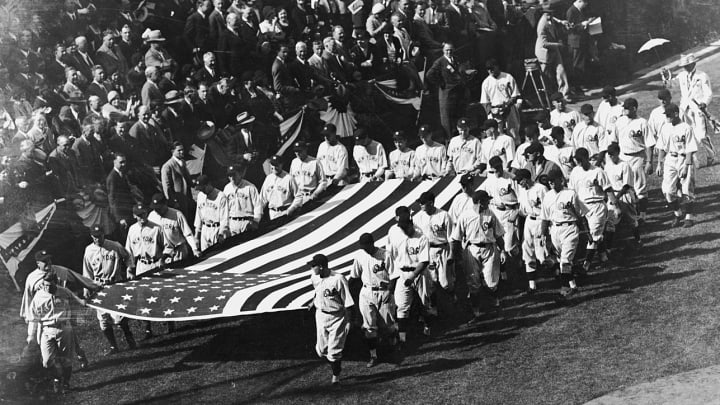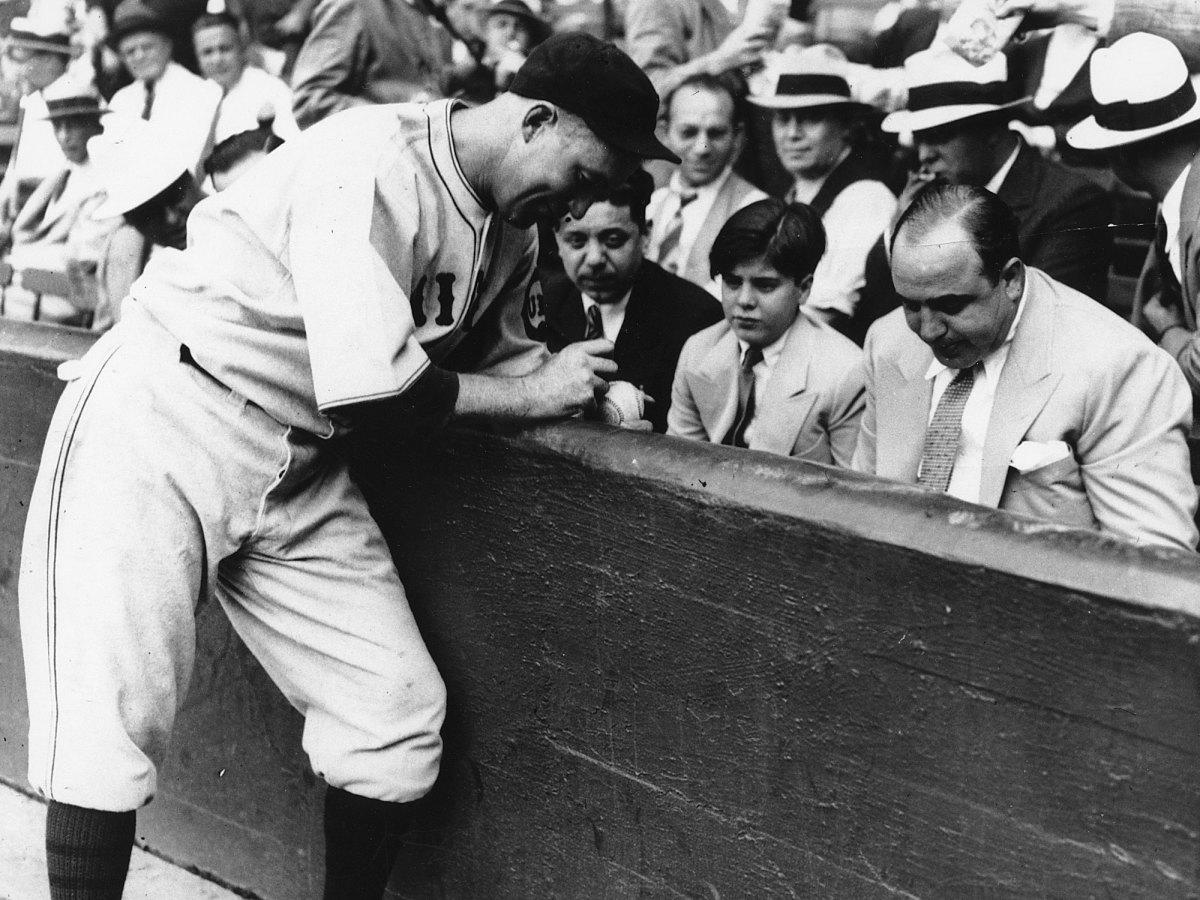From pop stars to the White House, the Cubs often embodied 20th century America

Excerpted from LIFE’s Chicago Cubs: Champions At Last, a 96-page, fully illustrated commemorative. Available at retailers and at Amazon by clicking here.
The Chicago Cubs were once synonymous with winning. Since the 1940s, the custom has been to #FlyTheW on the North Side—only the hashtag is new. The Cubs appeared in the World Series four times in the five years between 1906 and 1910—they were the first team to play in three consecutive Fall Classics—and won back-to-back championships in 1907 and '08. In the second half of that first decade of the 20th century, the Cubs’ double-play combination alone—shortstop Joe Tinker to second baseman Johnny Evers to first baseman Frank Chance—became shorthand for a kind of ruthless efficiency. A journalist named Franklin Pierce Adams published a 50-word verse about them in the New York Evening Mail on July 10, 1910, and it became one of the most popular American poems of the last century: “These are the saddest of possible words: Tinker to Evers to Chance / Trio of bear cubs, and fleeter than birds, Tinker and Evers and Chance . . .”
So embedded in the American culture were those early Cubs, with the Adams verse immortalizing them, that the poem still resonated more than 40 years later, when pulp-fiction king Raymond Chandler published The Long Goodbye, in which his hard-boiled detective Philip Marlowe says: “I went through my regular double-play with the morning mail. Mail slot to desk to waste-basket, Tinker to Evers to Chance.” Humphrey Bogart played Marlowe in the movies. The Cubs were always part of the great American mash-up.
In 1931, a suited Al Capone was photographed in the front row of Wrigley Field, asking Cubs catcher Gabby Hartnett to sign an autograph for his suited son, 12-year-old Al Capone Jr. Hartnett happily complied. Baseball commissioner Kenesaw Mountain Landis was not pleased to see the catcher and the gangster nearly nose to nose in the next day’s papers, and he ordered Hartnett, via telegram, to stop consorting with Capone and his ilk.
“Fine,” Hartnett wired back. “But you tell him.”
These were the Cubs of World War I, the Roaring Twenties, the Jazz Age edging into the Great Depression—consistently successful, and thus a draw, and not just for gangsters and other unsavory figures, though there were plenty of them. (A young Jack Ruby famously sold programs at Wrigley Field.)
Fin: The Cubs are World Series champions at last, and now there's only one thing to do
It was during these years that the Cubs acquired almost every aspect of what would become their 21st-century identity. Wrigley Field opened (as Weeghman Park) in 1914. The marquee was added in '34. Cubs executive Bill Veeck planted the ivy in '37. When the scoreboard went up in centerfield that same year, it was state-of-the-art. Only in the last half century did it acquire the retrofit modifier “hand operated,” so that it now calls to mind, for example, a “rotary dial” telephone, making it an artifact whose charm is its technological obsolescence.
In 1941, it was the first ballpark to feature organ music. The next year Cubs owner Phil Wrigley abandoned his plans to light the park that bore his name, and donated the 165 tons of steel meant to support the floodlights to the U.S. government. The Wrigley lights that never were helped win World War II instead, and it would be nearly five decades before those towers were installed. Soon after the war ended, the Cubs were the only team left in major league baseball playing only day games at home, the only team still lit exclusively by sunshine.
As the denizens of Wrigley proudly reveled in their sunny authenticity—this is the way baseball was meant to be played—an image began to take hold of the Cubs as innovators, lightless but enlightened. Alas, even though they’d made yet another World Series, in 1945, the Cubs and their fans had no way of knowing what awaited them: a profound period of loss and hard luck, a literal and figurative dark ages that began with a spell of dark magic.

*****
It had begun with such promise, that ’45 Series. The war was over, America’s postwar boom was just beginning, and the same was true, surely, for the Chicago Cubs, losers in the last six Series they had played. The Cubs led the Tigers two games to one on Oct. 6, 1945, when Billy Sianis, proprietor of the city’s Billy Goat Tavern, turned up at Wrigley with two tickets for Game 4. One seat was for him, the other for his pet goat and corporate mascot, Murphy, who wore a blanket emblazoned WE GOT DETROIT’S GOAT.
There are different versions of the legend that followed. In one account, Murphy was turned away at the gate, for even the Friendly Confines were not so friendly as to admit goats. In another telling, Murphy and Sianis took their seats inside but were asked to leave when the goat’s aroma offended other patrons. In either event, Sianis and Murphy slunk away in shame as the Cubs fell to the Tigers, 4–1. Sianis swore—either by telegram, or in a vague and spontaneous oath uttered on-site, or possibly both—that the Cubs would not win another World Series until Murphy was admitted, or otherwise avenged. What is beyond dispute is that four days later at Wrigley, the Tigers beat the Cubs 9–3 in Game 7 to take the Series. Though it wouldn’t gain cultural purchase for a couple of decades, the Curse of the Billy Goat had begun.
Get SI's commemorative package on the 2016 champion Chicago Cubs
In 18 of the next 21 seasons, the Cubs lost more games than they won, usually by a wide margin. But in September of 1953 the Cubs were joined by a Negro Leaguer from Dallas named Ernie Banks, late of the Kansas City Monarchs and the U.S. Army. Banks lit Wrigley Field when Mr. Wrigley himself could not, illuminating the pitch-dark tunnel the Cubs were in the midst of. Banks would win back-to-back league MVPs in ’58 and ’59 through the sheer force of his talent and an unwavering hope. Years later, he’d always say that his favorite song was from the Broadway musical Annie: “The sun’ll come out, tomorrow . . .”
In 1966, the Cubs lost 103 times. It was a low point that had its own supplemental nadir at the end of that summer, when, on Sept. 21, the home team and the Cincinnati Reds drew 530 fans to Wrigley Field. And yet that very season, Frank Sinatra was singing at the Sands in Las Vegas: “The jumpin’ Pump Room, Chicago is / The Chicago Cubbies, Chicago is . . .”
What was it about the Cubs that elicited such affection, even after such prolonged futility? The Cubs are like the American roots music embodied by singer Emmylou Harris, who once told MLB.com, "I don't have enough soul to be a Cubs fan. I wish I did."
America, though, is bound up in the Cubs, and the Cubs in America. Before the internet, before cable TV, when the Cubs’ longtime flagship, WGN, was only a radio station, Babe Ruth famously hit his “called shot,” gesturing to the centerfield bleacher fans at Wrigley, as legend has it, before smacking a home run directly to that spot off Cubs pitcher Charlie Root during the 1932 World Series. In doing so, Ruth broke the heart of a 19-year-old from Yorba Linda, Calif., who grew up rooting for the Cubs despite the physical distance from Wrigleyville.
Not anymore: A Cubs fan on his late grandfather and the wait that finally ended
“Charlie Root was a favorite of mine because he came up from Los Angeles, which used to be the Cubs’ farm team back in the days when they played at [L.A.’s] Wrigley Field,” Richard Nixon would say 37 years later. Those remarks came when Nixon was President of the United States, during a White House reception for major league All-Stars—including the entire Cubs starting infield—in July of 1969, when Chicago was cruising to a big lead in the National League East. Those ’69 Cubs were suddenly rounding into a team for the ages, with four future Hall of Famers: pitcher Ferguson Jenkins, third baseman Ron Santo outfielder Billy Williams and Mr. Cub himself, Ernie Banks, who had long borne the losing with his undimmed enthusiasm.
Their nine-game lead over the New York Mets on Aug. 16, 1969, had shriveled to a half-game advantage on Sept. 9, as Santo waited on deck in New York’s Shea Stadium. Suddenly, and absurdly, a black cat appeared on the field, passed in front of the visitors’ dugout, circled Santo as he waited his turn to bat, returned to the Cubs’ dugout, looked manager Leo Durocher in the eye, and then scampered back whence it came beneath the grandstand.
The Cubs lost 7–1 that night, their sixth consecutive defeat in an eight-game losing streak, and would never regain first place, so that the black cat was taken as a powerful omen: Things would not end well for the Cubs, or for President Nixon. The former watched the Mets win the World Series, the latter resigned five years later, ensnared in the Watergate imbroglio. The Washington Post reporters who uncovered the scandal, Bob Woodward and Carl Bernstein, in their historic account of that cover-up described Watergate news passing through the chain of command in the Nixon White House “like Tinker to Evers to Chance.”
